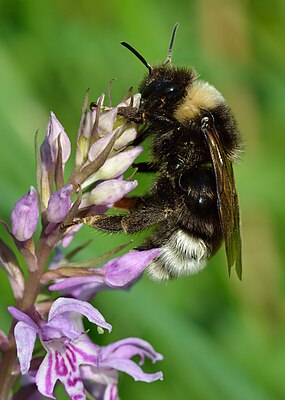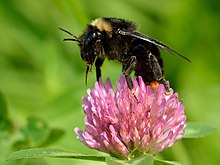Cuckoo bumblebees
| Cuckoo bumblebees | ||||||||||||
|---|---|---|---|---|---|---|---|---|---|---|---|---|

Tailed cuckoo bumblebee ( Bombus bohemicus ) |
||||||||||||
| Systematics | ||||||||||||
|
||||||||||||
| Scientific name | ||||||||||||
| Psithyrus | ||||||||||||
| Lepeletier , 1833 |
The cuckoo bumblebees ( Psithyrus ) are a subgenus of the bumblebees from the superfamily of bees .
Cuckoo bumblebees are social parasites of other bumblebees ( bombus ). Unlike other representatives of this genus, the cuckoo bumblebees have no special leg hair for collecting pollen . The group of workers is also absent in the colonies of these insects: A colony consists exclusively of drones and full females (who would be called queens among the bumblebees). Because of their parasitic way of life, these animals are named after the cuckoo , which allows its young to be raised by foreign parent animals. In the same way, the cuckoo bumblebees let the other bumblebees work for themselves, i.e. procure food, and take care of their young.
Way of life
Females of the European cuckoo bumblebee often resemble their host species (i.e. the social bumblebee species they parasitize) in their coloring and drawing , but this rule does not apply to the North American species of the subgenus. Müller's mimicry is suspected as a possible reason . After wintering, the cuckoo bumblebees appear a little later than the queens of the bumblebee species, where they parasitize. The female penetrates the nest of a bumblebee queen, which is still being built, and starts laying eggs there. This often leads to fights between the invading cuckoo queen and the workers living in the nest, which, however, as a rule will not hold up against the cuckoo. A fight between the two queens, on the other hand, seems to be the exception. The cuckoo bumblebees are similar to their host species in the specific composition of the hydrocarbon molecules of their cuticula , which is important for the recognition of the species, so they can possibly smuggle themselves into the nest undetected.
Cuckoo bumblebees are usually host specific. Only a single bumblebee species of 8 species is known to be the host, in 8 others there are few (2 to 5), usually related species. Insufficient data are available for the other species. Cuckoo bumblebees are generally rarer than their hosts, their range is usually smaller, especially towards the edge of the host's area. As a result, they are more threatened with extinction than their common bumblebees.
Consequences for the hosts
The greater danger for the landlord queen is that she will be neglected by her own workers.
The invaded cuckoo bumblebee now begins with the oophagia , that is, it consumes the eggs of the host queen while it itself begins to lay eggs. Conversely, the eggs of the cuckoo bumblebee are occasionally consumed by the host queen and the remaining workers.
Hatched cuckoo bumblebees do not take part in gathering food and hardly take part in brood care. They also leave the nest of the Bombus people to mate. The mated full females overwinter like the queens of the bombus bumblebees in hidden places.
Systematics
For a long time, the cuckoo bumblebee was viewed by most authors as an independent genus. Phylogenetic studies in the 1990s showed, however, that cuckoo bumblebees and bumblebees are not in a sister group relationship to one another, the genus Bombus is paraphyletic after splitting off from Psithyrus . The common peculiarities in the physique of the cuckoo bumblebee are above all an adaptation to the parasitic way of life. One solution would be to split the genus Bombus into further genres, which most experts reject because of the pronounced uniformity of the group. According to the currently accepted status of the system, Psithyrus is therefore only regarded as a subgenus of Bombus .
The subgenus Psithyrus is monophyletic according to phylogenomic analyzes (comparison of the relationship based on homologous DNA sequences) . This means that the cuckoo bumblebees form a natural family group; the parasitic species are not closely related to their hosts.
The sub-genus includes almost 30 species with almost worldwide distribution, wherever their hosts live, i.e. H. in the Holarctic , Southeast Asia and South America. Cuckoo bumblebee species are lacking in the relatively few bumblebee species in the high mountains and tropical latitudes. Many species are widespread, at least two of which are found in both Europe and North America. In addition, two socially parasitic bumblebee species are known that do not belong to Psithyrus .
Types (selection)
- Bearded cuckoo bumblebee ( Bombus (Psithyrus) barbutellus ) - hosts: Bombus hortorum , Bombus hypnorum
- Tailed cuckoo bumblebee ( Bombus (Psithyrus) bohemicus ) - Host: Bombus lucorum
- Field cuckoo bumblebee ( Bombus (Psithyrus) campestris ) - hosts: Bombus pascuorum , Bombus humilis , Bombus pomorum , Bombus pratorum
- Yellow Alpine Cuckoo Bumblebee ( Bombus (Psithyrus) flavidus ) - Host: Bombus jonellus
- Norwegian cuckoo bumblebee ( Bombus (Psithyrus) norvegicus ) - host: Bombus hypnorum
- Four-colored cuckoo bumblebee ( Bombus (Psithyrus) quadricolor ) - Host: Bombus soroeensis
- Rock cuckoo bumblebee ( Bombus (Psithyrus) rupestris ) - host: Bombus lapidarius
- Forest cuckoo bumblebee ( Bombus (Psithyrus) sylvestris ) - hosts: Bombus pratorum , Bombus jonellum
- Chaste cuckoo bumblebee ( Bombus (Psithyrus) vestalis ) - host: Bombus terrestris
The information about the hosts is based on the Scandinavian treatment by Astrid Løken
Individual evidence
- ↑ Paul H. Williams (2008): Do the parasitic Psithyrus resemble their host bumblebees in color pattern? Apidology 39: 637-649. doi : 10.1051 / apido: 2008048
- ↑ Stephen J. Martin, Jonathan M. Carruthers, Paul H. Williams, Falko P. Drijfhout (2010): Host Specific Social Parasites (Psithyrus) Indicate Chemical Recognition System in Bumblebees. Journal of Chemical Ecology 36 (8): 855-863. doi : 10.1007 / s10886-010-9805-3
- ↑ Jukka Suhonen, Janina Rannikko, Jouni Sorvari (2015): The Rarity of Host Species Affects the Co-Extinction Risk in Socially Parasitic Bumblebee Bombus (Psithyrus) Species. Annales Zoologici Fennici 52 (4): 236-242. doi : 10.5735 / 086.052.0402
- ^ Paul H. Williams, Sydney A. Cameron, Heather M. Hines, Bjorn Cederberg, Pierre Rasmont (2008): A simplified subgeneric classification of the bumblebees (genus Bombus). Apidology 39: 46-74. doi : 10.1051 / apido: 2007052
- ^ SA Cameron, HM Hines, PH Williams (2007): A comprehensive phylogeny of the bumble bees (Bombus). Biological Journal of the Linnean Society 91: 161-188.
- ↑ Heather M. Hines (2008): Historical Biogeography, Divergence Times, and Diversification Patterns of Bumble Bees (Hymenoptera: Apidae: Bombus). Systematic Biology 57 (1): 58-75. online at JSTOR
- ↑ Astrid Løken (1984): Scandinavian species of the genus Psithyrus Lepeletier (Hymenoptera: Apidae). Entomologica scandinavica, Supplementum 23: 1-45.






